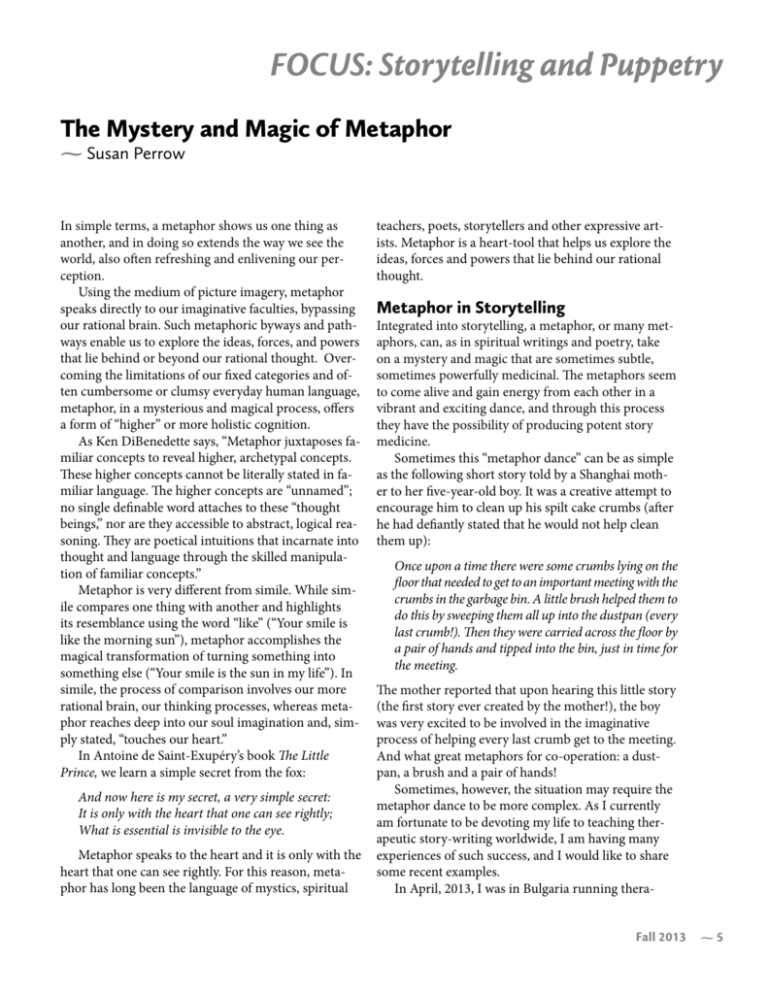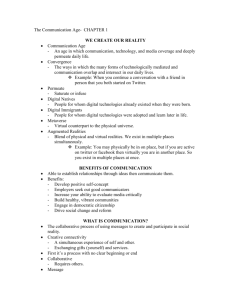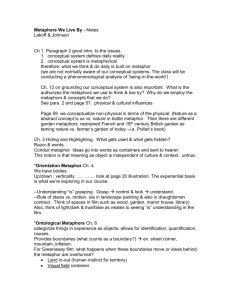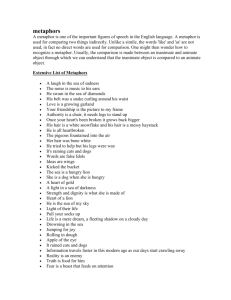
FOCUS: Storytelling and Puppetry
The Mystery and Magic of Metaphor
Susan Perrow
In simple terms, a metaphor shows us one thing as
another, and in doing so extends the way we see the
world, also often refreshing and enlivening our perception.
Using the medium of picture imagery, metaphor
speaks directly to our imaginative faculties, bypassing
our rational brain. Such metaphoric byways and pathways enable us to explore the ideas, forces, and powers
that lie behind or beyond our rational thought. Overcoming the limitations of our fixed categories and often cumbersome or clumsy everyday human language,
metaphor, in a mysterious and magical process, offers
a form of “higher” or more holistic cognition.
As Ken DiBenedette says, “Metaphor juxtaposes familiar concepts to reveal higher, archetypal concepts.
These higher concepts cannot be literally stated in familiar language. The higher concepts are “unnamed”;
no single definable word attaches to these “thought
beings,” nor are they accessible to abstract, logical reasoning. They are poetical intuitions that incarnate into
thought and language through the skilled manipulation of familiar concepts.”
Metaphor is very different from simile. While simile compares one thing with another and highlights
its resemblance using the word “like” (“Your smile is
like the morning sun”), metaphor accomplishes the
magical transformation of turning something into
something else (“Your smile is the sun in my life”). In
simile, the process of comparison involves our more
rational brain, our thinking processes, whereas metaphor reaches deep into our soul imagination and, simply stated, “touches our heart.”
In Antoine de Saint-Exupéry’s book The Little
Prince, we learn a simple secret from the fox:
And now here is my secret, a very simple secret:
It is only with the heart that one can see rightly;
What is essential is invisible to the eye.
Metaphor speaks to the heart and it is only with the
heart that one can see rightly. For this reason, metaphor has long been the language of mystics, spiritual
teachers, poets, storytellers and other expressive artists. Metaphor is a heart-tool that helps us explore the
ideas, forces and powers that lie behind our rational
thought.
Metaphor in Storytelling
Integrated into storytelling, a metaphor, or many metaphors, can, as in spiritual writings and poetry, take
on a mystery and magic that are sometimes subtle,
sometimes powerfully medicinal. The metaphors seem
to come alive and gain energy from each other in a
vibrant and exciting dance, and through this process
they have the possibility of producing potent story
medicine.
Sometimes this “metaphor dance” can be as simple
as the following short story told by a Shanghai mother to her five-year-old boy. It was a creative attempt to
encourage him to clean up his spilt cake crumbs (after
he had defiantly stated that he would not help clean
them up):
Once upon a time there were some crumbs lying on the
floor that needed to get to an important meeting with the
crumbs in the garbage bin. A little brush helped them to
do this by sweeping them all up into the dustpan (every
last crumb!). Then they were carried across the floor by
a pair of hands and tipped into the bin, just in time for
the meeting.
The mother reported that upon hearing this little story
(the first story ever created by the mother!), the boy
was very excited to be involved in the imaginative
process of helping every last crumb get to the meeting.
And what great metaphors for co-operation: a dustpan, a brush and a pair of hands!
Sometimes, however, the situation may require the
metaphor dance to be more complex. As I currently
am fortunate to be devoting my life to teaching therapeutic story-writing worldwide, I am having many
experiences of such success, and I would like to share
some recent examples.
In April, 2013, I was in Bulgaria running theraFall 2013
5
peutic storytelling workshops for psychologists. One
group worked on a story for a five-year-old girl who
had, one month beforehand, lost her father to a sudden illness. Because he had died at home in his sleep,
the girl was extremely fearful of going to sleep, and
also fearful of her mother going to sleep. She would
do everything she could to try and stay awake—run
around the house, scream and cry, refuse to lie down.
. . and when, out of sheer exhaustion she would fall
asleep, she would wake up a few hours later and run to
her mother and wake her up. The grieving mother had
gone to the psychologist with sleep exhaustion, asking
for help. The group worked on a story to hopefully
help the little girl “want to go to sleep.”
You may wonder where one begins with such a story. The girl’s greatest interests were ballet and ballerina
dolls, so this was my recommended starting point (I
suggest you refer to my book Therapeutic Storytelling
for an extensive list of tips on choosing metaphors).
Here is the completed story (loosely translated
from Bulgarian):
There was once a beautiful ballerina that lived inside
a music box on top of a strong table in a little colored
house at the edge of town. Every day the music box lid
would open and the ballerina would dance round and
round and round. Oh, how she loved to dance. When
she was tired the music box lid would close and she
could rest. And so life went on, day after day—the ballerina would dance, then rest, then dance some more.
One day everything changed in the life of the beautiful ballerina. While she was resting in her music box,
a terrible storm came in the night and shook the colored house so strongly that the table rocked backwards
and forwards and almost fell over. One of the table legs
cracked and fell off, and the music box lid flew open
so wide that it wasn’t able to close again. The ballerina woke up and began to dance, round and round and
round—she danced all day and all night and all the next
day—round and round and round—she danced and
danced and could not stop.
One evening the Spirit of Dreams (a character from
Bulgarian folklore) was passing by the window of the
little colored house. She looked in and saw the ballerina dancing round and round, and knew she could be of
some help. So she slipped inside and sang a special song
to help the music box lid find a way to close again. That
night the ballerina was able to have a long, long rest,
and the next morning the Spirit of Dreams was back
again, this time to sing a different kind of song—a wake
up song. The music box lid opened and the ballerina
was able to dance round and round and round. Oh, how
6
Gateways Issue 65
this ballerina loved to dance! Now with the help of the
Dream Spirit, life could go on, day after day—the ballerina could dance, then rest, then dance some more.
Three weeks later I received the following email
from the mother’s psychologist: “This story did something amazing. The girl liked it very much and asked
her mother to tell her the story several times. The
story reduced the girl’s tension and anxiety to a great
extent. She asked a lot of questions about the Spirit of
Dreams. We established contact with a young woman
studying at The Academy of Arts in Sofia who painted the Dream Spirit on the wall over the girl’s bed. The
effect was just like in a fairy tale. The problem with the
sleep seems to be solved.”
In this situation, the choice of metaphors (ballerina, music box, table, storm, dream spirit) danced
together in a therapeutic story journey and created
powerful story medicine to help the girl want to go to
sleep each night.
A very different story line was used in a workshop
in North America. The desired resolution was to find
new strength and life following the suicide of a father.
The group worked with a nature cycle theme. The story was about a strong oak tree toppled over by a great
storm. Where the roots had been torn out, a baby
acorn was dropped into the earth. Cradled in the arms
of the acorn shell, in the dark of the earth, all alone,
the acorn slowly began to sprout. This situation was
quite different from the one in Bulgaria, and the group
felt it was important that the story should be written
for the mother, to encourage her to find strength to
cradle and support her child.
Working with the mystery and magic of metaphor,
therapeutic stories can address a range of issues, from
aggressive behavior to grieving, anxiety, lack of confidence, bullying, teasing, nightmares, intolerance, inappropriate talk, toilet training, bedwetting and much
more. Therapeutic stories also have the potential for
nurturing positive values and building emotional resilience and character.
There are so many different situations where a story can offer help for children, teenagers and adults. In
Portland, Oregon a teacher wrote a story about a Yellow Bird for an adopted Chinese child who was being
teased at school. After telling the story several times
in class the teacher shared it with the mother, who
commented that she knew something had happened
because the tears had stopped and the child seemed
much happier before going to bed. In Croatia a mother and therapist together worked on a story about a
heavy stone necklace, which was for a fourteen-year-
old girl who could no longer walk and needed to use
a wheelchair, but was refusing to do so. The teenager
wrote an email of thanks to me, saying that the story
had encouraged her to accept the help of the wheelchair. A twenty-two-year old Kenyan man, approaching his death, used a story about a family of rabbits to
say honest and important things about his life, things
that his culture would not have allowed him to express. A fifty-five-year-old woman wrote her own story to deal with her sexual abuse when she was three
years old.
There is such a need and a thirst today for story
medicine. And intrinsic to the art of therapeutic story
writing is the art of using metaphor.
In writing a healing story it helps to carefully select therapeutic metaphors and to construct a journey or quest to meet the need of the situation and the
age of the child or teenager. The story is not intend-
There are so many different
situations where a story
can offer help for children,
teenagers, and adults.
ed to moralize or to induce guilt; this point cannot
be stressed enough! The objective is to simply reflect
what is happening and, through the story “metaphors”
and “journey” provide an acceptable means of dealing
with the behavior and a positive resolution. A healing
tale should, as much as possible, leave the listener free
to come to her or his own conclusion. This way the
“power of story” is left to do its work, as Ben Okri suggests, “in silence, invisibly”:
It is easy to forget how mysterious and mighty stories
are. They do their work in silence, invisibly. They
work with all the internal materials of the mind and
self. They become part of you while changing you.
(Birds of Heaven, p. 34).
As a vital ingredient in therapeutic story making,
metaphors help to form imaginative connections that
draw in and “enchant” the listener. As integral parts of
the story journey, they often play both negative roles
(obstacles, hindrances and tempters or temptations
that help to pull a behavior or situation out of balance)
and positive roles (helpers or guides that bring the behavior/situation back into wholeness or balance).
Try to picture the following: a story is written for
a child who is annoying other children, and the story
is directly about a child who is always annoying other
children but learns to stop when the other children
refuse to be friends. If such a story is told in class, because it lacks metaphors to help “lift” the listeners into
their imaginations, the group could be trying to work
out who the story is about, and suddenly the teacher could be interrupted by someone calling out, “Josh
does the same, he annoys everyone!” It is even questionable whether such an example, devoid of metaphoric imagery, could be called a story.
Let us now take the same example and build a story with metaphor. Starting first with “simile” can be a
helpful inroad to story making. “It’s as if an annoying,
obnoxious child is like an octopus whose tentacles are
getting into everything.” Then drop the “as if ” and “is
like: and our story can begin:
Occy Octopus was a continual worry for his ocean
friends. He always seemed to be annoying one, or pestering another, or bothering all of them at once. Whatever the friends were doing, wherever the friends were
going, Occy’s eight long tentacles would get in the way.
One tentacle might be hooked onto Crab’s claw, another one reaching inside Groper’s mouth, another tickling
Star Fish’s feet, another dragging clumps of seaweed into
their play.
As well as Occy’s tentacles being obstacles in the
story, the ocean friends, because of their negative
chanting, also become obstacles.
Go away, Occy, go away, we don’t like the way you
play, Go away, Occy, go away, your tentacles are in the
way!
Then Turtle enters as the wise helper. More “helping” metaphors along the story journey are the long
piece of seaweed, and the community involvement to
help pull it along. The resolution is Occy’s “self progress” towards keeping his tentacles under control—
and learning the true way to swim.
This story, with the use of both obstacle and
helping metaphors, offers a simple transformational journey from “annoying friends and lack of control” to “enjoyable friendships and better self-control.”
Through a light and humorous approach, the story
leads to a positive resolution and the behavior is restored to balance.
(For the full story, “Obnoxious Octopus,” see my
ebook, A Spoonful of Stories: An A - Z Collection of Behavior Tales for Children.)
As an exercise in experiencing and understanding
the use of metaphor in story making, I suggest you
read some folk and fairy tales, then make up a table
of your own, identifying both the obstacles and the
helpers. But be forewarned! You may find a story that
Fall 2013
7
has metaphors that don’t fit either of these categories.
An interesting discovery at a recent workshop was
that some metaphors seem to play a “transitional” or
“transformational” or “turning point” role. And sometimes a metaphor may play a ‘thread’ or central role.
What other roles can metaphors play? This is work in
progress for me, so the question is genuine!
It is also important to note that, depending on the
story journey, the same metaphors can assume different roles. For example, in one context a “lagoon” can
be an obstacle for a trapped whale to escape from (to
overcome); in another it can play a protective, helping
role for a boat that has come to shelter from the storm.
This of course reflects the fluid nature of life and the
dynamic changes of meaning that occur depending on
context and situation.
Metaphor Seeds
Sometimes a metaphor may be used as a seed idea
only, not even a full story. In my first book I wrote
about a wise dentist who explained to my seven-yearold that one of his teeth needed a silver star to make
it strong. The use of picture language here (instead of
the word “filling”) made a considerable difference in
the attitude of my son in accepting the situation. I also
reported on a father who used the image of a waterfall
to successfully teach his four-year-old son to pee directly into the toilet and not all over the sides and top.
I have since heard that a teacher in Croatia helped to
potty train her two-and-a-half-year old nephew using
the same picture language. Apparently there was a
stream near the boy’s home with a little waterfall, and
after visiting it for several days he loved the idea of being able to pull down his nappy and make a waterfall
himself. From then onwards he would cry “waterfall”
in time to reach the toilet and did not need a diaper
anymore, for both watery and rocky waterfalls!
I am fortunate to know some creative health professionals who work with metaphor in clinical practice, for all ages of patients. Some draw metaphors
from the patients’ interests or professions to help them
build links to their diagnosis: the connection of goal
scoring to winning, for a keen football fan who needs
a healthier life style; poor structural beams, for an
engineer who needs to do more exercise to build up
basic muscle tone; clogged pipes, for a plumber with
a cholesterol problem; an out-of-tune instrument, for
a musician with a broken leg who needs to do physiotherapy to help retune/re-strengthen his muscles.
Some use metaphors related to the illness: for example, a pressure cooker without a safety valve (blood
8
Gateways Issue 65
pressure). One doctor keeps a collection of figurines
on a tray on his desk (including people, animals, trees,
houses, fairy tale characters) as a point of lateral reference for his patients to start connecting with their
condition in a metaphoric way. This way the patients
are helped to find their own metaphors for their own
unique situation.
All of the above report that this pictorial approach
seems to reach the patients in a more effective way and
also helps them feel truly “heard.” The healing power
of metaphor has no bounds!
I am confident that many early childhood teachers
reading this article must have a wonderful repertoire
of metaphor seeds (picture talk) that they use within their programs. I encourage you to email them to
me—perhaps they could be the basis of another article
on this mysterious and magical subject.
Happy metaphor dancing!
•
This article © 2013 by Susan Perrow. All rights reserved.
References
De Saint-Exupéry, Antoine. The Little Prince (Scholastic,
1978).
DiBenedette, Ken. Quoted on Sylvia Plath’s poem “Sheep in
Fog” at //moonchalice.com/WordPress/?p=17#respond.
Original source of quotation not found.
Okri, Ben. Birds of Heaven (London: Phoenix, 1996).
Perrow, Susan. Healing Stories for Challenging Behaviour
(Hawthorn Press, 2008).
__________. A Spoonful of Stories: An A - Z Collection
of Behaviour Tales for Children. (Ebook)
__________. Therapeutic Storytelling (Hawthorn
Press, 2012).
Susan Perrow is an Australian whose “work”
passion is stories and storytelling. She is a writer,
storyteller, teacher trainer and parent educator. For the
last thirty years she has been documenting stories from
other cultures, writing stories and telling stories to
groups of children and adults—all this woven in with
a career in teaching and teacher training in Australia,
Africa, Asia, Europe and the US/Canada.
Susan is planning a North American tour in April/May
2015. If your school is interested in inviting her to run a
therapeutic storytelling training or conference, please
contact her at susanperrow@gmail.com.








